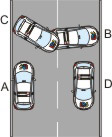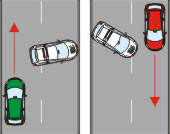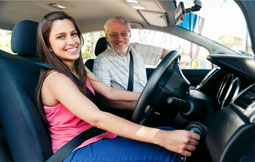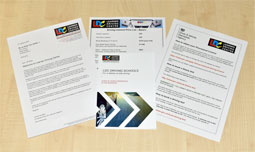Driving lesson M5. Turn in the road
Introduction
The purpose of the turn in the road manoeuvre is to turn the car to face the opposite direction by using the forward and reverse gears. At this stage in the programme you should have mastered all the component skills that make up this manoeuvre; the angle start, reversing to the left and reversing to the right. The key to this manoeuvre is fast steering and slow speed via good clutch control.
Key learning notes
If you found yourself in a dead end road it might be the only manoeuvre that you could use to turn around safely.
The start of the turn is similar to an 'angle start'. As you move across to position B, you will be using clutch control to maintain a slow, safe speed and using your observational skills to keep looking for other vehicles around your car. Steer briskly to the right as you start to move, but before you reach the kerb at position B steer briskly to the left.
After you have stopped at position B, you will reverse to the left (after a slight uphill start). Move across to position C, but before you reach the kerb steer briskly to the right.
From this point move across to position D which is your normal driving position.

The additional learning points for this manoeuvre are:
1. Location
Choose a location that is quiet and where you have as much room as possible. Avoid locations where there are trees or posts or other obstructions near or on the kerb. Keep away from parked vehicles and ensure that you will be easily seen by approaching traffic. Once your vehicle is broadside across the road (i.e. in positions B or C in the earlier diagram) you are very vulnerable to approaching traffic from either direction.
2. Steering
Being able to change the lock of the steering wheel briskly just before you reach point B and point C is the key to completing the manoeuvre in as few movements as possible.
3. Handbrake and clutch control
The camber of the road may require you to apply the handbrake at point B and C to prevent the car from rolling forward and backwards. It will also require you to use your previously learnt clutch control and braking skills.

4. All round awareness
All round observations are particularly important to this manoeuvre as you need to be aware of traffic approaching from either side of your vehicle while watching for
pedestrians who might cross from the front or the rear. Therefore when you are moving forward you are continually looking from side to side while looking ahead. When reversing you continually move from looking over your left shoulder to your right shoulder as appropriate.
5. Dealing with other vehicles
The manoeuvre should not be started until the road is clear of traffic in both directions. Once you have completed the first leg, any traffic that is waiting can pass behind you if they want to. Similarly, before commencing the third leg you can allow any waiting traffic to pass in front of you if they want to. The same would apply if it took further movements forwards and backwards to complete the manoeuvre.

6. Number of movements needed
It may not always be possible to complete the manoeuvre in three legs or movements. Additional movements forward and backwards may be needed particularly if the road is very narrow. The procedure for these additional movements is basically the same.











